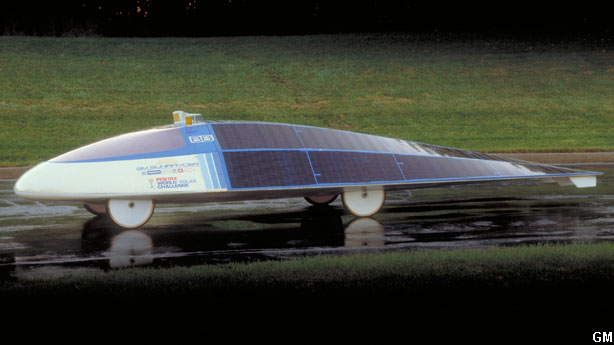
The world's most difficult race might be the Indianapolis 500, which subjects neck-strong drivers to more than three hours of lateral forces five times that of gravity. Then again, it could be an endurance affair like the 24 Hours of Le Mans, a battle of will that includes driver changes, in-car urination and the kind of (lack of) sleep regimen you'd expect from a 12-year old with a new copy of Gran Turismo. But there's a good chance none of those come close to the 1,950-mile, continent-spanning World Solar Challenge. This sun-powered marathon is arguably the greatest automotive race in the world considering the level of innovation, the range of entries (everybody from corporations to universities to high schools), and the overall badassedry involved.
 The inaugural event, staged in 1987, brought out a host of entries from around the world but none would come remotely close to the Sunraycer, a three-way collaboration between General Motors, GM Hughes Electronics and AeroVironment Inc. Roughly 20 feet long, six and a half feet wide, but only a little over three feet tall, the Sunraycer looked like a fish filet on wheels. Journalists at the time dubbed it the "flying cockroach."
The inaugural event, staged in 1987, brought out a host of entries from around the world but none would come remotely close to the Sunraycer, a three-way collaboration between General Motors, GM Hughes Electronics and AeroVironment Inc. Roughly 20 feet long, six and a half feet wide, but only a little over three feet tall, the Sunraycer looked like a fish filet on wheels. Journalists at the time dubbed it the "flying cockroach."
Crossing Australia in 44 hours and 54 minutes at a rate of 41 MPH, drivers found some solace from the 120-degree temps in the gold-plated canopy over their heads. It blocked out 90% of the visible light and almost all the infrared rays, but driving the Sunraycer was not a job for the out of shape. Including nightly stops (remember: no sun, no run), the total trip took five and a half sweaty days.
Doesn't sound like too much of a race, does it? Consider that the next closest finisher, an entry from Ford, crossed the line some two days later. The Sunraycer operated nearly perfectly in the race, save for three flat tires. All 7,200 of its solar cells -- about 90 square feet, roughly the size of an average American kitchen -- functioned quite well. Total weight, not including the driver, was a remarkable 360 pounds, or about 1/10th the curb weight of an average family sedan today.
The Sunraycer is now in the Smithsonian's permanent collection at the Museum of American History in Washington, D.C. The World Solar Challenge lives on in biannual events (the new distance is 1,877 miles), with the next race planned for 2011.


Sign in to post
Please sign in to leave a comment.
Continue